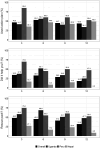Chronic Obstructive Pulmonary Disease Self-Management in Three Low- and Middle-Income Countries: A Pilot Randomized Trial
- PMID: 37698443
- PMCID: PMC10867931
- DOI: 10.1164/rccm.202303-0505OC
Chronic Obstructive Pulmonary Disease Self-Management in Three Low- and Middle-Income Countries: A Pilot Randomized Trial
Abstract
Objectives: Chronic obstructive pulmonary disease (COPD) disproportionately affects low- and middle-income countries. Health systems are ill prepared to manage the increase in COPD cases. Methods: We performed a pilot effectiveness-implementation randomized field trial of a community health worker (CHW)-supported, 1-year self-management intervention in individuals with COPD grades B-D. The study took place in low-resource settings of Nepal, Peru, and Uganda. The primary outcome was the St. George's Respiratory Questionnaire (SGRQ) score at 1 year. We evaluated differences in moderate to severe exacerbations, all-cause hospitalizations, and the EuroQol score (EQ-5D-3 L) at 12 months. Measurements and Main Results: We randomly assigned 239 participants (119 control arm, 120 intervention arm) with grades B-D COPD to a multicomponent, CHW-supported intervention or standard of care and COPD education. Twenty-five participants (21%) died or were lost to follow-up in the control arm compared with 11 (9%) in the intervention arm. At 12 months, there was no difference in mean total SGRQ score between the intervention and control arms (34.7 vs. 34.0 points; adjusted mean difference, 1.0; 95% confidence interval, -4.2, 6.1; P = 0.71). The intervention arm had a higher proportion of hospitalizations than the control arm (10% vs. 5.2%; adjusted odds ratio, 2.2; 95% confidence interval, 0.8, 7.5; P = 0.15) at 12 months. Conclusions: A CHW-based intervention to support self-management of acute exacerbations of COPD in three resource-poor settings did not result in differences in SGRQ scores at 1 year. Fidelity was high, and intervention engagement was moderate. Although these results cannot differentiate between a failed intervention or implementation, they nonetheless suggest that we need to revisit our strategy. Clinical trial registered with www.clinicaltrials.gov (NCT03359915).
Keywords: COPD; community health workers; global health; self-management.
Figures



Comment in
-
Role of Community Health Workers in Chronic Obstructive Pulmonary Disease Care in Low- and Middle-Income Countries.Am J Respir Crit Care Med. 2023 Nov 15;208(10):1012-1013. doi: 10.1164/rccm.202309-1640ED. Am J Respir Crit Care Med. 2023. PMID: 37787613 Free PMC article. No abstract available.
References
-
- World Health Organization. 2023. https://www.who.int/news-room/fact-sheets/detail/chronic-obstructive-pul...
-
- Lin CE, Wood JJ. In: Encyclopedia of autism spectrum disorders. Volkmar FR, editor. New York: Springer; 2013. Self-management interventions; pp. 2735–2743.
Publication types
MeSH terms
Associated data
Grants and funding
LinkOut - more resources
Full Text Sources
Medical

